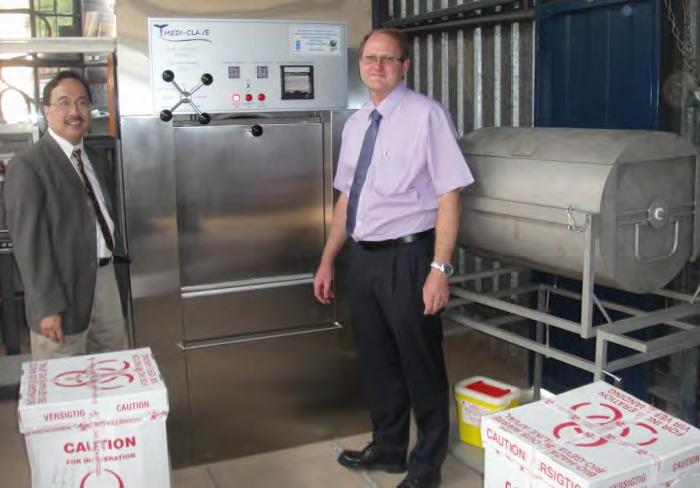As efforts to stem the Ebola outbreak in West Africa continue, a new design of autoclave is being deployed to help make the treatment of infectious waste safe environmentally sustainable.
Treating patients with Ebola generates huge amounts of infectious waste, including the used suits that the healthcare workers use to protect themselves while they work. In a lot of treatment centers, the only option has been to burn the waste in barrels, bury it in pits, or use low-tech incinerators which emit a huge amount of pollutants and create toxic ash. In contrast, autoclaves are far more environmentally friendly. They use high temperature and pressure steam to disinfect the waste. All that is needed is water and electrical power. No pollutants are created, and autoclaving has a much smaller carbon footprint that burning or incinerating.
Autoclaves as a Solution
The new autoclaves have been designed by the South African company Medi-Clave, working with Jorge Emmanuel, Chief Technical Expert from the United Nations Development Program (UNDP)/Global Environment Facility (GEF) Global Healthcare Waste Project, in which WHO and Health Care Without Harm were Principal Cooperating Agencies (www.gefmedwaste.org).
Starting in early 2015, HCWH will be working with UNDP and WHO on a new GEF-funded project, which will disseminate non-incineration waste treatment technologies in four African countries- Ghana, Madagascar, Tanzania and Zambia. Lessons learned during this deployment of autoclaves in the Ebola Treatment Units will be valuable for this new project.
Conditions in Africa can be tough on machinery, so the new autoclave has a number of special adaptations to avoid breakdowns. For example, the electronic control systems that control modern autoclaves have been replaced with an older but more robust method of mechanical controls. The autoclave also comes with a metal drum to collect the waste, and a trolley to carry it. These allow the users to collect, transport, load and unload the waste safely and with the minimum effort.
Installing the Autoclaves
The first two autoclaves have been installed in Ebola Treatment Units (ETUs) in Sierra Leone. Another 8 will be installed in February and others sent to Liberia and Guinea, the countries most affected by the worst ever Ebola outbreak. In total, 30 autoclaves will be installed.
When the outbreak is over, these machines will be moved to hospitals to treat the healthcare waste that they generate and strengthen the health systems for years to come.
More information
- Read Jorge Emmanuel's journey to West Africa.
- Watch video showing the installation of the first autoclaves, source: UNIFEED.
- Read UNDP's Press Release
- Read Jorge Emmanuel's and Prof Dr Babacar Ndoye presentation on the waste treatment autoclave project in Liberia
- Listen to the radio story on the autoclave work in Liberia
Photo Description
Jorge Emmanuel (left), and Johan Hoffman (right), co-designers of the new autoclave, with one of the first units to be produced. Dr Emmanuel is Chief Technical Expert from the United Nations Development Program (UNDP)/Global Environment Facility (GEF)/World Health Organization (WHO)/Health Care Without Harm Global Healthcare Waste Project. Johan Hoffman (right) is Managing Director and Chief Engineer of the Medi-Clave company that co-designed and produced the autoclaves.
